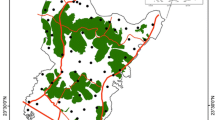Abstract
There is an urgent need to identify the human influence on landscape as disturbance regimes was realized for prioritization of the protected areas. The present study has attempted to describe the landscape level assessment of fragmentation and disturbance index in protected areas of Rajasthan using remote sensing and GIS techniques. Geospatial analysis of disturbance regimes indicates 61.75% of the total PAs are under moderate disturbance index followed by 28.64% and 9.61% under low and high respectively. Among the 28 protected areas- National Chambal WLS, Jaisamand WLS, Kumbhalgarh WLS, Sawai Man Singh WLS, Kailadevi WLS and Bandh Baratha WLS are representing high level of disturbance. The present study has emphasized the moderate to low disturbance regimes in protected areas, which infer low biotic pressure and conservation effectiveness of PA network in Rajasthan. The spatial information generated on PAs is of valuable use for forest management and developing conservation strategies.









Similar content being viewed by others
References
Ambastha K R and Jha C S 2010 Geospatial analysis of Tamil Nadu Eastern Ghats forest types at landscape level with reference to fragmentation and species diversity; In: Biodiversity and Landscape Ecology, J. Indian Soc. Remote Sens. 38 453–463.
CBD 2004 Secretariat of the Convention on Biological Diversity, Biodiversity issues for consideration in the planning, establishment and management of protected area sites and networks. Montreal, SCBD, i–iv. (CBD Technical Series no. 15), 164p.
Forman T T and Godron M 1986 Landscape Ecology; John Wiley & Sons, New York.
FSI 2011 State of Forest Report; Forest Survey of India, Ministry of Environment and Forests (MoEF), Government of India (GoI).
Hari Krishna P and Reddy C S 2012 Assessment of increasing threat of forest fires in Rajasthan, India using multitemporal remote sensing data (2005–2010); Curr. Sci. 102(9) 1288–1297.
IIRS 2002 Biodiversity characterisation at landscape level in north-east India using remote sensing and Geographical Information System; Indian Institute of Remote Sensing, Dehra Dun, 296p.
IIRS 2011 Biodiversity characterization at landscape level in northwest India and Lakshadweep islands using Remote Sensing and Geographic Information System; Indian Institute of Remote Sensing, Dehra Dun, 277p (ISBN: 978-81-211-0774-7).
Kiester A R, Scott J M, Csuti B, Noss R F, Buterfield B, Sahr K and White D 1996 Conservation prioritisation using GAP data; Conser. Biol. 10(5) 1332–1342.
Karanth K K, Curran L M and Reuning-Scherer J D 2006 Village size and forest disturbance in Bhadra Wildlife Sanctuary, Western Ghats, India; Biological Conservation 128 147–157.
Ludeke A K, Maggio R C and Reid L M 1990 An analysis of anthropogenic deforestation using logistic regression and GIS; J. Environ. Manag. 31 247–259.
Lyon J G 1983 Landsat-derived land cover classification for locating potential Kestrel nesting habitat. Photogramm; Engg. Remote Sens. 49(2) 245–250.
Nandy S and Kushwaha S P S 2010 Geospatial modelling of biological richness in Sunderbans; In: Biodiversity and Landscape Ecology, J. Indian Soc. Remote Sens. 38 431–440.
Pattanaik C, Reddy C S and Murthy M S R 2010 Geospatial modeling of biological richness in Kuldiha Wildlife Sanctuary of Orissa, India; J. Indian Soc. Remote Sens. 38 477–485.
Reddy C S 2008 Catalogue of invasive alien flora of India; Life Sci. J. 5(2) 84–89.
Reddy C S, Hari Krishna P and Ravikiran A 2011 Mapping the vegetation types of Rajasthan, India using remote sensing data; J. Environ. Res. Manag. 2(1) 1–9.
Romme W H 1982 Fire and landscape diversity in subalpine forests of Yellowstone National Park; Ecol. Monogr. 52 199–221.
Roy P S, Kushwaha S P S, Roy A, Karnataka H and Saran S 2013 Biodiversity characterization at landscape level using geospatial model; Anais XVI Simpósio Brasileiro de Sensoriamento Remoto – SBSR, Foz do Igua¸cu, PR, Brasil, INPE, pp. 3321—3328 (http://www.dsr.inpe.br/sbsr2013/files/p0140.pdf).
Roy P S and Tomar S 2000 Biodiversity characterisation at landscape level using geo-spatial modeling technique; Biological Conservation 95 95–109.
Roy P S, Tomar S and Jegannathan C 1997 Biodiversity characterisation at landscape level using satellite remote sensing; NNRMS Bulletin B-21 12–18.
Sakarwal S K and Ashok V 2008 Protected areas of Rajasthan. Conserving Biodiversity of Rajasthan; Himanshu Publications, pp. 16–30.
Salem B B 2003 Application of GIS to biodiversity monitoring; J. Arid Environ. 54 91–114.
Singh V and Singh M 2006 Biodiversity of Desert National Park, Rajasthan; Botanical Survey of India, Kolkata.
Subin K J, Alex C J, Santhosh K, Abin V and Madhu G 2011 Landscape Metric Modeling – a technique for forest disturbance assessment in Shendurney Wildlife Sanctuary; Environmental Research, Engineering and Management 4(58) 34–41.
Turner M G 1987 Landscape Heterogeneity and Disturbance; Springer-Verlag, New York.
Acknowledgements
Authors are thankful to Dr V K Dadhwal, Director, NRSC and Dr P S Roy, Former Director, IIRS, Dehradun for suggestions and encouragement. The present work is carried out as part of national project on ‘Biodiversity characterization at landscape level using satellite remote sensing and geographical information system’ with financial support of Department of Space and Department of Biotechnology, Govt. of India.
Author information
Authors and Affiliations
Corresponding author
Rights and permissions
About this article
Cite this article
KRISHNA, P.H., REDDY, C.S., SINGH, R. et al. Landscape level analysis of disturbance regimes in protected areas of Rajasthan, India. J Earth Syst Sci 123, 467–478 (2014). https://doi.org/10.1007/s12040-014-0409-0
Received:
Revised:
Accepted:
Published:
Issue Date:
DOI: https://doi.org/10.1007/s12040-014-0409-0




